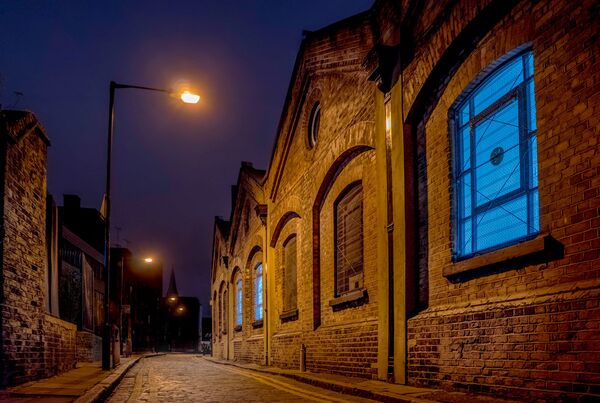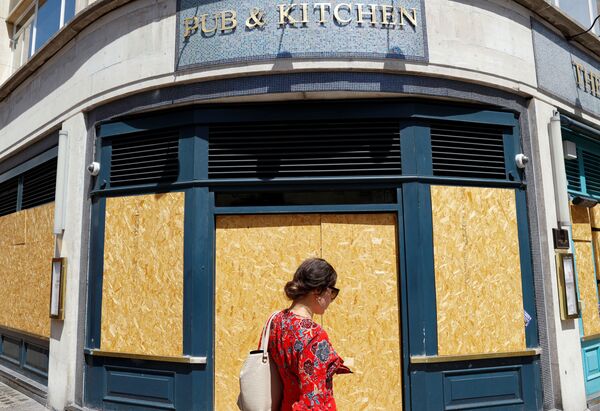British Prime Minister Boris Johnson has outlined plans to allow pubs and restaurants to reopen from 4 July after Health Secretary Matt Hancock said COVID-19 was "in retreat".
Mr Johnson said on Tuesday, 23 June, the government was relaxing its social distancing guidelines from two metres to one metre and that meant that it would be possible for customers to be in pubs without breaking the rules. Pubs will however have to monitor distancing and discourage hugging and other forms of contact.
I for one am not looking forward to the pubs reopening. 🤣 pic.twitter.com/4aswKtZeqc
— 🔸Zig n Zag (@Its_Zig_n_Zag) June 22, 2020
The government has come under intense pressure from the drinks industry - which is worth billions of pounds to the economy - to allow pubs to reopen in time for the height of summer.
Pubs are unique to Britain and Ireland. So what are the most famous ones?
Britain's Smallest Pub
The Nutshell in the quaint market town of Bury St. Edmunds in Suffolk lays claim to the title of the country’s smallest pub.
The bar in The Nutshell measures just 4.5 metres by two metres, which means that even in “normal” times it can only accommodate 15 customers. But with social distancing in place it will be down to single digits, which may make it not worth reopening.
It rained, we poured beer, the Morris Men danced & you supported us. Thanks to everyone who braved the elements today for the traditional Boxing Day #Morrismen visit to all 5 pubs in Claygate. #Platform3Claygate pic.twitter.com/wGknlLd5C6
— Platform 3 Claygate (@SmallestPubinUK) December 26, 2019
In recent years The Nutshell’s claim to fame been challenged by a micropub which opened on the platform of a train station used by commuters heading into and out of London.
Platform 3, as it is known, has been closed for the duration of the lockdown but has been delivering beer to thirsty customers in the area.
Britain's Oldest Pub
There have been taverns and inns in England, Scotland, Wales and Ireland since the Middle Ages, if not before.
When stagecoaches were the main means of transport they often stopped at inns which were strategically placed along main roads, a bit like today’s motorway service stations. The horses would be fed and rested in the stables and the driver and passengers would drink, eat and sometimes sleep in the inn before continuing, re-energised.
nothing has changed, there is still no vaccine, virus still circulating, there is still no effective test and trace regime despite the govt having three months to get it set up, if you willingly go to a pub you're playing Russian roulette with others lives #PubsReopening
— you are cool.🏳️🌈 (@dumbmongreldog) June 23, 2020
Market towns also had their own taverns, which served thirsty locals as well as farmers who had come to buy and sell cattle and sheep.
Nottingham’s Ye Olde Trip to Jerusalem is said to be the oldest pub in England - it was said to have been built into the rocks which form part of Nottingham Castle in 1189 and has caves underneath it.
But there is a rival claimant - The Old Ferryboat Inn in Cambridgeshire.
The pub’s owners claim beer and mead has been sold on the premises since the sixth century and it is also haunted by the ghost of a teenage girl who hanged herself….in the 11th century.
Britain’s Biggest Pub
J D Wetherspoons was a chain of pubs founded in 1979 by entrepreneur Tim Martin, who has swum against the tide of pub closures.
Wetherspoons now own 900 pubs around the country and have a proven formula - a wide selection of real ales and spirits and good food in commodious surroundings at very affordable prices.
With the #PubsReopening soon just a reminder to #boycottwetherspoons
— 𝚂𝚎𝚕𝚒𝚗𝚊 𝚓 (@OfSelina) June 23, 2020
Tim Martin very much remains a bellend
Other pubs are available
Many Wetherspoons pubs are very big but there is none bigger than The Regal in Cambridge - a former cinema.
It reopened as a pub in 2000 and can hold 1,300 customers.
Wetherspoons said last month it had spent £11 million on changes to its pubs to allow them to operate safely - including replacing condiment bottles with disposable sachets and employing cleaners to wipe up around the pubs during the day.
Pubs With Dark Histories
Britain is so steeped in pub culture that it is inevitable there are links between pubs and violent crime, especially in London.

The Ten Bells in Whitechapel is regularly visited by foreign tourists seeking out the ghost of Jack The Ripper and his victims. In 1888 Mary Kelly, 25, was drinking in the pub before stepping out into the darkened streets and becoming the infamous serial killer’s final victim.
Barely a mile away is The Blind Beggar pub, where in 1966 infamous gangster Ronnie Kray shot dead George Cornell in front of a crowd of regular drinkers. Cornell had been badmouthing Kray - calling him a “fat poof”.
Kray and his twin brother Reggie, who had ruled the East End of London with a reign of terror - were later jailed for life.
The Magdala pub in Hampstead, north London, also has a place in the annals of English criminal history. Ruth Ellis - the last woman to be executed in Britain - shot dead her lover outside The Magdala in 1955.
The pub closed in 2016 but locals are fighting for it to reopen, rather than be converted into apartments.
In Edinburgh the World’s End pub also has a dark tale attached to it - in 1977 two teenager girls, Christine Eadie and Helen Scott, were last seen drinking in the pub.

Thirty years later Angus Sinclair was acquitted of their murders but was put on trial again in 2014 and this time jailed for life.
In Northern Ireland, during The Troubles, there were a number of murders carried out in pubs.
In 1993 a UDA gang killed eight drinkers at The Rising Sun in Greysteel and the following year a group of UVF gunmen killed six Catholics in O’Toole’s pub in the village of Loughinisland, while the IRA regularly bombed pubs associated with the security forces - most famously in the 1970s when they killed scores in bomb attacks in Birmingham, Guildford and Woolwich.
Pubs in Soap Operas
Soap operas - first on radio in the 1950s and later on television - have long been popular in Britain and in an attempt to make them realistic the producers realised they needed these fictional worlds to have pubs.
Please remember, pub owners and restaurateurs aren’t expecting to open in july and MAKE money.
— Adam Brooks (@EssexPR) June 23, 2020
I’ll bite your hand off to break even and stop the losses.
This is about survival and jobs#PubsReopening
Coronation Street - which is set in Manchester and first aired in 1960 - revolves around The Rovers' Return, while EastEnders - which is set in east London - features heavily the Queen Victoria, or Queen Vic, pub.
Another popular ITV soap - Emmerdale, which is set in Yorkshire - includes many scenes in The Woolpack pub.
But the big daddy of them all is The Archers - which has run on BBC radio since 1950 - and is set in the fictional village of Ambridge, which has a pub called The Bull, said to be based on a real pub in Worcestershire.
Pubs in Literature
English, Scottish, Welsh and Irish literature is full of pubs, inns and taverns.
Daphne DuMaurier’s famous novel Jamaica Inn was set in the eponymous pub in Cornwall. The inn, high on Bodmin Moor, was reputedly used by smugglers and shipwreckers in the 18th century.
Alcohol features heavily in Shakespeare’s plays and the Visit Britain website lists four pubs where the playwright reportedly drank in, including The George Inn in London and The Windmill in Stratford-upon-Avon.
Absolute genius #PubsReopening pic.twitter.com/iFI59E86WR
— Maya Birch (@Mayabirch1) June 21, 2020
Among Shakespeare’s many beer-sodden quotes is this one from Henry V: "I would give all my fame for a pot of ale and safety."
J R R Tolkien, who was brought up in Warwickshire and Birmingham, was heavily influenced by Anglo-Saxon cuIture and the Inn of the Prancing Pony, which is frequented by Bilbo Baggins in The Hobbit, is redolent of an English village pub.
More recently J K Rowling created The Three Broomsticks in her Harry Potter books, although the young characters in the film famously drank butterbeer rather than alcohol.
The Three Broomsticks has been recreated in Orlando, Florida as part of a Harry Potter theme park.


